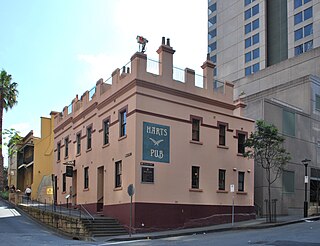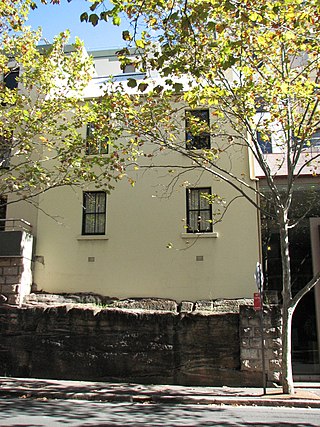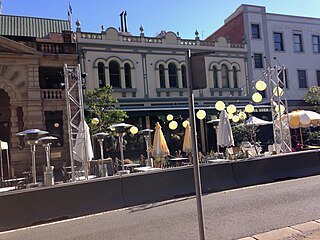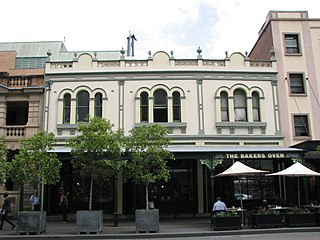Heritage listing
As at 18 November 2008, 145 George Street, The Rocks, was constructed in 1893 as part of a group of four buildings and has State heritage significance for its historic and social cultural values. [1]
145 George Street has historic significance at State level for having been the site of early European settlement and has been continuously occupied by Europeans since 1788. The site has historic significance at local level for its associations with several phases of late 19th and 20th century urban renewal. Firstly, the commercial development of The Rocks in the last decade of the 19th century when the building was purpose-built as a grocery store; secondly, the demolition and rebuilding of much of The Rocks under the Observatory Hill Resumption Act following the 1900 plague outbreak; thirdly association with infrastructure works, including the construction of the City Railway link and the Cahill Expressway, which dramatically changed the visual curtilage of the group; and lastly, the 1980s creation of The Rocks as a tourist destination, when the interior and rear of the building was altered to accommodate the Duty Free Store Complex. 145 George Street has historic significance at local level for its associations with Downton & Dyer, a prominent local business that started as a grocery store in the late 19th century, developed as a wholesale business and is currently a major dry food supplier company that continues to operate in Sydney in larger premises under the same company name. [1]
The East Elevation of 145 George Street has high aesthetic significance at local level associated with being a representative example of a Victorian Regency style commercial building designed in the last decade of the 19th century. In the 1980s the West Elevation, much of the ground floor and upper floor interiors were altered. While this has reduced the ability to interpret the building's significance, the eastern façade contributes to the aesthetic and historic diversity of the George Street streetscape. A street awning, in keeping with the original design, was reinstated. Shopfronts while not identical to the original, were sympathetic in design and character to turn of the century shopfronts. [1]
145 George Street forms part of a group of four commercial buildings (Nos. 145, 147, 149–151 and 153–155 George Street) which front the eastern portion of the DFS (Duty Free Store) complex. This group of buildings, bounded by Globe Street and the Cahill Expressway, mark George St's southern entry to The Rocks precinct. The facades of the four late 19th century and early 20th century buildings have streetscape qualities and character that contribute to the overall richness of a coherent and harmonious brick and stucco group of buildings located within The Rocks. Within its location in The Rocks, which has State heritage significance, the subject site and the building group as a whole, contributes to a precinct unique to NSW with its historic associations and streetscape character. The group is an important part of The Rocks Heritage Conservation Area being sympathetic in scale and character and an extension of the remaining earlier buildings of George St, presenting a unified streetscape. The buildings are tangible evidence of the redevelopment of The Rocks in the last decade of the 19th century and first decade of the 20th century. 145 George Street has high social significance as a contributory element associated with the historic character of The Rocks, which is held in esteem by the local community and the people of NSW. [1]
Shop and Residence was listed on the New South Wales State Heritage Register on 10 May 2002 having satisfied the following criteria. [1]
The place is important in demonstrating the course, or pattern, of cultural or natural history in New South Wales.
145 George Street is a three-storey face brick building on the corner of Globe Street. The building was erected between 1892 and 1893 as shops and offices. 145 George Street has associations as a built element within George Street and Globe Street. George Street is the oldest street in Australia and Globe Street is one of the earliest cross streets. 145 George Street has high significance at local level associated with a corner shop operating continuously on the site and managed by the same proprietor, for almost ninety years. The business changed in over 80 years from a single-owner grocery store to a wholesale providores. The company moved from The Rocks to accommodate an expanding business. 145 George Street has moderate significance at local level for its associations with the phase of redevelopment of The Rocks in the 1980s when the precinct was transformed into a major tourist attraction. The item meets this criterion at State level. [1]
The place has a strong or special association with a person, or group of persons, of importance of cultural or natural history of New South Wales's history.
145 George Street has moderate historic significance at local level for its association with the grocery company, Downton & Dyer Ltd, who operated from The Rocks from 1879 before Jesse Dyer moved to the premises at the corner of Globe and George Streets in 1893. The company amalgamated to become Downton & Dyer in 1918. [1]
The place is important in demonstrating aesthetic characteristics and/or a high degree of creative or technical achievement in New South Wales.
The four brick buildings (Nos. 145; 147, 149–151 and 153–155 George Street) of heritage significance, which as a group, provide evidence of two phases of commercial activity in The Rocks just before and just after the plague outbreak and subsequent resumption of land at the turn of the century. Although compromised by the loss of rear sections, ground floor interiors and street awnings in the 1980s, it remains a coherent and harmonious brick and stucco group. The buildings are the representative of the commercial architecture of the Federation period and the transitional phase prior to the turn of the century. They are tangible evidence of the redevelopment of The Rocks in the early 20th century and also the more recent redevelopment period associated with the SCA. These buildings also provide evidence of historical association with prominent local business such as W. A. Grubb butchers. The Central Sydney Heritage Inventory contains separate listings for the building facades of 145–151 George St. and the former New York Hotel at 153-155 George Street: "Of environmental significance for its contribution to an architecturally diverse and historically important commercial streetscape of heritage significance as physical evidence of the growth and consolidation associated with the maritime activities at Circular Quay". The group of four buildings was classified as part of the George Street Business Precinct by the National Trust of Australia in the mid 1970s: "A group of four compatible Edwardian buildings containing interesting and lively fenestration which combine to present a picturesque street elevation. The group acts as a sympathetic extension to the remaining earlier buildings of George Street in scale and character to present a unified streetscape". The above listings indicate that the primary significance of the group is their contribution to the historic streetscape as well as their aesthetic value as a group of Federation period commercial buildings. [1]
The place has a strong or special association with a particular community or cultural group in New South Wales for social, cultural or spiritual reasons.
The Rocks in general has considerable significance to the general community of Sydney and the people of NSW as a heritage precinct. The Rocks of which the subject site forms a part, is important to the community's sense of place and is subsequently held in esteem. Shopping is a major activity within The Rocks area. As the first commercial district of Sydney relating directly to the ports and shipping, the area has developed a strong commercial focus, which is currently maintained by tourism. The subject site has maintained its historic association with shopping and retail. The item meets this criterion at State level. [1]
The place has potential to yield information that will contribute to an understanding of the cultural or natural history of New South Wales.
The earliest and most substantial phase of building on the subject site and in close proximity occurred by 1822. These earliest buildings, located along the George Street frontage, comprised the Underwood Buildings, an adjacent shop to the north and Thomas Moore's house. Archaeological evidence from a series of cottages erected on the southern section of the site during the 1820-30s has probably been removed by later 19th and 20th century developments. Due to considerable disturbance related to construction works, the subject site has little scientific/ research significance and does not meet this criterion. [1]
The place possesses uncommon, rare or endangered aspects of the cultural or natural history of New South Wales.
There are numerous examples of Victorian/Federation style corner shop buildings within The Rocks that are similar to 145 George Street. The item does not meet this assessment criterion. [1]
The place is important in demonstrating the principal characteristics of a class of cultural or natural places/environments in New South Wales.
The shops and shopping district of The Rocks are representative of the continuing commercial use of the area and the change to tourism. 145 George Street is one of the group of shop buildings that operated in The Rocks from the end of the 19th century until the late 20th century. 145 George Street is representative of this group and meets the criterion at local level. [1]






















